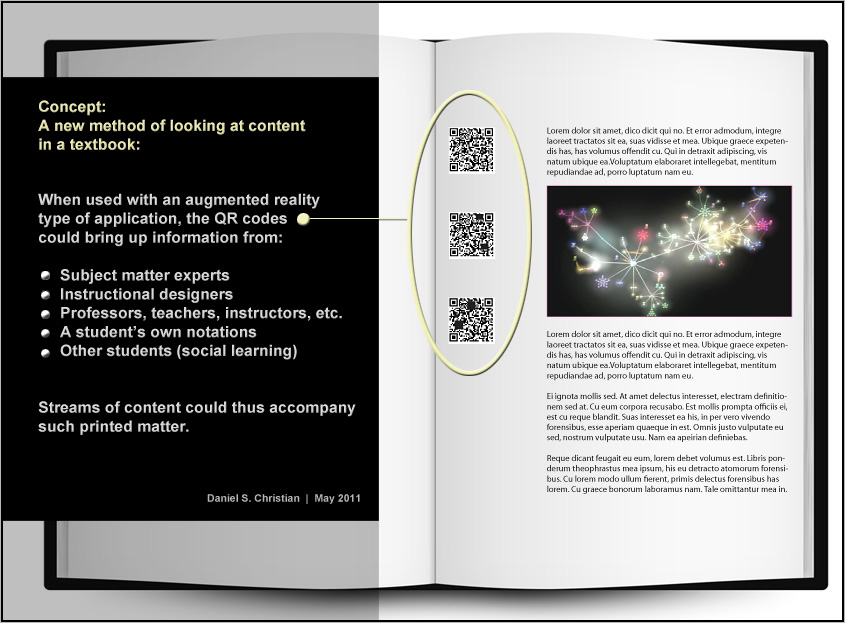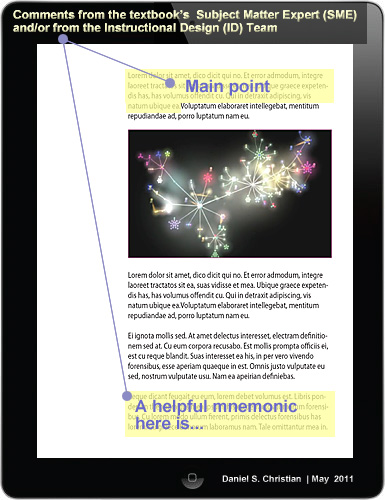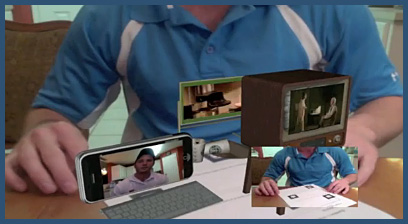From DSC:
Taking this concept into learning spaces…I would like to see this type of thing in all Smart Classrooms; for example:

Also see:
- Send your Handwritten Notes to Google Docs with Livescribe — from Digital Inspiration by Amit Agarwal




From DSC:
Taking this concept into learning spaces…I would like to see this type of thing in all Smart Classrooms; for example:

Also see:
echalk — from www.echalk.de
From DSC:
I’m looking for a technology that can capture 20 feet worth of “chalkboard” for longer mathematical problems and solutions and equations. How can we capture that?
Perhaps I’m not thinking clearly, but tablets don’t seem nearly large enough to fit these types of work on them in their entirety. Document cameras are another potential option, but again, the writing surface is too small. That goes for PolyVision’s Eno Board, Smart’s Interactive Whiteboards, BrightLink Projectors from Epson and other similar products.
That’s why E-Chalk caught my attention.
I’m trying to free up students’ minds — to allow them to be cognitively engaged with — and present with — the content being discussed (vs. having to madly write down the equations before the professor erases the board). I want them to walk away with such writings on a device and/or accessible somewhere on the cloud.
E-chalk is more than a traditional chalkboard because it integrates multimedia elements:
The NMC Horizon Report: 2011 K-12 Edition, a research effort led and published by the New Media Consortium, is rolling out at three important venues over the next few weeks. Three international organizations — the New Media Consortium, the Consortium for School Networking (CoSN), and the International Society for Technology in Education (ISTE) — collaborate on identifying technology experts and other aspects of the research, and this year, for the first time, each organization is planning a significant event related to the new report for each of their audiences.
[Concept] The new “textbook”: A multi-layered approach — from Daniel S. Christian
I’ve been thinking recently about new approaches to relaying — and engaging with — content in a “textbook”.
For a physical textbook
When opening up a physical textbook to a particular page, QR-like codes would be printed on the physical pages of the textbook. With the advent of augmented reality, such a mechanism would open up some new possibilities to interact with content for that page. For example, some overall characteristics about this new, layered approach:

For an electronic-based textbook


Advantages of this concept/model:
Addendum (5/26):
12 fabulous Flip Camera alternatives for education — from 21centuryedtech.wordpress.com by Michael Gormans
Excerpt from introduction (emphasis DSC):
Three factors are driving this new interest and enthusiasm for digital learning by educators. First, teachers and administrators are increasingly become technology-enabled themselves, using emerging technologies such as mobile devices, online classes and digital content to improve their own productivity. This development of a personal value proposition with the technology is propelling educators to think creatively about how to leverage these same tools in the classroom. Second, students and increasingly parents are demanding a different kind of learning experience and that is forcing even the most reluctant teachers and administrators to re-evaluate their perspectives about the value of technology within learning. As noted in prior Speak Up national reports, students have a very clear vision for 21st century learning. Their preference is for learning environments that are socially-based, un-tethered and digitally rich. Parents are also supportive of this new learning paradigm and as we noted in our first Speak Up 2010 report (released in April 2011) the emergence of a new trend of parental digital choice is an indication of this unprecedented support level. And schools and districts are waking up to this new trend. Concerns about parents’ capability to, for example, enroll their children in non-district provided online classes are compelling many districts to start virtual schools themselves. The third factor, the economy, and its resulting financial pressures on school and district budgets, has created a sense of urgency to more fully investigate how technologies can help educators meet their instructional goals with less expense.
All three factors converging at the same time has opened up a new window of possibilities for achieving the promise of technology to transform education. Evidence of this shift in perspective and vision by educators is noted in some comparative Speak Up findings over the past few years.
…
This report is the second in a two-part series to document the key national findings from Speak Up 2010.
…
In this companion report, “The New 3E’s of Education: Enabled, Engaged, Empowered – How Today’s Educators are Advancing a New Vision for Teaching and Learning,” we explore how teachers, principals, district administrators, librarians and technology coordinators are addressing the student vision for learning around three key trends. These trends have generated significant interest in the past year at conferences, in policy discussions and within our schools and districts: mobile learning, online and blended learning and digital content.
While each of these trends includes the essential components of the student vision of socially-based, un-tethered and digitally-rich learning, they also provide a unique backdrop for investigating the role of educators to engage, enable and empower students through the use of these emerging technologies.
• Role of Librarians and Technology Coordinators: To enable student use of the emerging technologies through their planning, support and recommendation responsibilities.
• Role of Classroom Teachers: To engage students in rich, compelling learning experiences through the effective use of these technologies in the classroom.
• Role of School and District Administrators: To empower both teachers and students to creatively envision the future of digital learning, and to provide opportunities for exploring the elements of a new shared vision for learning.
How the iPad can help learning disabled students — from techlearning.com by guest blogger Vicki Windman
Excerpt:
Students with learning disabilities may have problems with reading, math, reasoning and recall. But given the appropriate tools, learning disabled students too can achieve academic success. The iPad has numerous apps to help learning disabled students compensate for their particular disability.
New Augmented Reality Tools: Play Videos on Your Worksheets — from K12 Mobile Learning blog by Johnny Kissko
Also see:
Online learning begins to explode into mainstream in blended schools — from Disupting Class posted by Michael Horn
This week, Innosight Institute, where I am the executive director of the education practice, released a landmark report, titled The rise of K-12 blended learning: Profiles of Emerging Models, which profiles 40 different operators leading the rise of K-12 blended learning.
Across America a skyrocketing number of K-12 students are getting their education in blended-learning environments. Over 4 million K-12 students took at least one online course in 2010, according to Ambient Insight, and this space is growing now by a five-year compound annual growth rate of 43 percent—much faster than the growth of charter schooling or other K-12 education reforms, for example. And the majority of this growth is occurring in different types of “blended learning.”
Also see:
Boosting productivity in US higher education — from McKinsey Quarterly by Cota, Jayaram, Laboissière
Excerpt:
The United States needs more college graduates. Opinions vary on exactly how many, but McKinsey estimates that the nation will need an additional one million each year by 2020 to sustain its economic health. That would mean increasing today’s annual total—2.5 million—by 40 percent.
To meet this goal, universities and colleges would have to increase their output of graduates by 3.5 percent a year over the next decade. That’s a daunting task for two reasons. First, it would cost an additional $52 billion a year, based on 2008 costs to produce a graduate. Yet many states, plagued by fiscal woes, have recently lowered spending on higher education, a trend that’s unlikely to be reversed. Second, to achieve this increase, colleges would need to enroll many more than 3.5 percent more freshmen each year, because today, on average, only 40 percent of students who enroll go on to graduate.
From DSC:
I realize that many in education don’t view Bill and Melinda Gates with a great deal of admiration or respect. However, they and their foundation are about to make a hugely positive difference in — and contribution to — education. I’m sure that these grants will help create solutions that will feature professionally-done, highly-engaging, interactive, multimedia-based, team-created educational content. I hope that many of the solutions will feature sophisticated back-end engines that will allow for highly personalized/customized learning.
This is huge because such solutions are highly scalable. Plus look at who is involved at this point:
Also see:
Also see:
Study: 30% of all US households already have TV connected to Internet
 New consumer research from Leichtman Research Group, Inc. (LRG) finds that 30% of all households have at least one television set connected to the Internet via a video game system, a Blu-ray player, and/or the TV set itself — up from 24% a year ago. Overall, 10% of all adults watch video from the Internet via one of these devices at least weekly, compared to 5% last year. This increased usage is heavily driven by Netflix subscribers, with 30% of Netflix subscribers watching video from the Internet via one of these connected devices weekly, compared to 3% weekly use among all non-Netflix subscribers.
New consumer research from Leichtman Research Group, Inc. (LRG) finds that 30% of all households have at least one television set connected to the Internet via a video game system, a Blu-ray player, and/or the TV set itself — up from 24% a year ago. Overall, 10% of all adults watch video from the Internet via one of these devices at least weekly, compared to 5% last year. This increased usage is heavily driven by Netflix subscribers, with 30% of Netflix subscribers watching video from the Internet via one of these connected devices weekly, compared to 3% weekly use among all non-Netflix subscribers.
Also see:
Addendums:
From DSC:
Why post this? Because:
Passion-based learning in the 21st century: An interview with Sheryl Nussbaum-Beach — from plpnetworks.com by John Norton
Sheryl Nussbaum-Beach often speaks of the “moral imperative” for K12 educators to assure that all students gain the skills, knowledge and dispositions they need to be successful in a connected world “where the ability to think critically, collaborate effectively and master increasingly powerful digital technologies” will determine their success in school, college and careers.
Nussbaum-Beach has been an educator for 20 years, serving as a public school classroom teacher, technology coach, charter school principal, district administrator, university instructor, and digital learning consultant. She is a frequent international speaker and the chief executive officer of Powerful Learning Practice LLC, a company she founded with educator-author Will Richardson to provide “professional development for 21st century educators.” PLP’s client list includes public, parochial and independent schools in the United States, Canada, Australia and Norway.
Nussbaum-Beach is also president of the digital consulting firm 21st Century Collaborative, LLC and a doctoral candidate at The College of William and Mary. She serves on the advisory board for the 2011 Horizon Report on trends in K12 education. Her first book, The Connected Educator, will be published by Solution Tree later this year.
In this interview, Sheryl describes the “shift” she believes must take place in teaching and learning practices if elementary and secondary schools expect to remain relevant in an era when information and communication technologies will continue to expand exponentially.
Also see:




